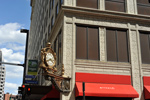
Macy’s Puts Historic Downtown Building Up For Sale
By Kim Leonard and Sam Spatter, PITTSBURGH TRIBUNE-REVIEW
Thursday, July 1, 2010

The clock outside the Macy's store has lasted longer than the name above the door of the Downtown fixture, which in 1885 became home to a store doing business as Kaufmann Brothers. Justin Merriman | Tribune-Review
Macy’s is putting its historic, 13-story Downtown store on the selling block, with plans to lease back part of the space.
The department store chain didn’t name an asking price for the landmark that fills a block on Smithfield Street, between Forbes and Fifth avenues. Macy’s retail operations fill 10 floors, and offices are on part of a separate floor.
Macy’s Inc. has been considering its options for the Downtown building — which was the flagship store of Kaufmann’s for most of its history — during the past year or two, spokesman Jim Sluzewski said Wednesday.
“Our initial goal is to sell the building, and then lease back the space we need for a store and offices,” he said. If that can’t be done, Macy’s could find tenants for unused or now-underused space in the building, he said.
Sluzewski said the amount of space Macy’s retains in the building will “depend on discussions with a potential buyer.”
Commercial real estate firm Cassidy Turley of St. Louis is marketing the store, which has 750,000 square feet of space, nearly 14 football fields.
Macy’s is jumping into the Downtown real estate market at a time when other major buildings also are for sale — Gateway Center, the Henry W. Oliver Building, EQT Tower, the Regional Enterprise Center and the Red Cross Building.
“The Downtown Pittsburgh market is extremely active now and is attracting a lot of interest,” said Pat Sentner, a principal with real estate firm NAI Pittsburgh Commercial.
The department store chain’s intent to lease part of the building makes it attractive to buyers, he said. But what’s important is how much space the retailer wants, and for how long, he said.
“If 75 percent or more of the building is part of the leaseback arrangement, that could attract an institutional type of investor” such as an investment group or foundation, Sentner said. If Macy’s wants half the space or less, a corporation or law firm might want to buy the building and use most of it for offices, he said.
Preserving the store in some form is key to keeping Downtown healthy and vibrant, observers said.
“It’s important to keep Macy’s Downtown and continue it as a retailer of excellent merchandise,” said Mike Edwards, president of the Pittsburgh Downtown Partnership. “I’ve seen it in other cities. Department store owners are retailers who don’t want to own real estate.”
Retail expert C. Britt Beemer said Macy’s closed stores in several downtown areas in recent years. “Pittsburgh is fortunate to have one, and it’s good to maintain downtown stores — they have a history and a sense of integrity.”
“Department stores used to be major property owners in many cities. Now they’re mainly tenants in malls and shopping centers,” said Beemer of America’s Research Group in Charleston, S.C.
Cincinnati-based Macy’s owns 469 of its 850 Macy’s and Bloomingdale’s stores. Spokesman Sluzewski said Macy’s always is looking to maximize its use of space in stores. The company maintains many downtown stores, he said, citing 15 other examples.
Patricia Edwards of Storehouse Partners LLC in Seattle said department store chains, especially in the rough economy of recent years, “are really trying to make sure each individual store is profitable, as opposed to just the chain itself.”
In September 2006, Macy’s kicked off its new presence Downtown and elsewhere in the region with a block party on Smithfield Street. It promised to keep the landmark corner clock at Smithfield and Fifth, the Tic Toc restaurant on the first floor, holiday events and other favorite Kaufmann’s features.
Still, Duquesne University marketing professor Audrey Guskey said shoppers in the region gave Macy’s a lukewarm reception.
“A lot of people were disappointed in the quality of merchandise, the service and the hours,” she said. “Also, Macy’s goal was to become a national department store, and they were very cookie-cutter — the Pittsburgh stores were like Cleveland, L.A. and Chicago.” Macy’s since then has been tailoring merchandise to various regions’ tastes, Guskey added.
In the past three decades, Downtown has lost four department stores, including a Lord and Taylor department store next to the Macy’s building.
Macy’s sales nationwide last year totaled $23.5 billion, down 5.6 percent from 2008. The company’s profit was $350 million, after a $4.8 billion loss in 2008.
____________________________________________________________________________________
• 1877: Brothers Jacob and Isaac Kaufmann open a four-story store at Smithfield Street and what now is Forbes
Avenue, moving their tailoring business from the South Side.
• 1885: Store becomes Kaufmann Brothers, filling a block between Forbes and Fifth avenues.
• 1913: Another expansion brings the store to 12 stories.
• 1946: May Department Stores Inc. acquires Kaufmann’s.
• 1955: A 10-story addition on the store’s Fifth Avenue side is built, along with a parking garage.
• 2002: May closes Kaufmann’s headquarters on the Downtown store’s upper floors. About 1,200 jobs are lost.
• 2005: Macy’s parent, Federated Department Stores Inc., buys May company.
• 2006: Kaufmann’s and department stores in other cities that were part of May are changed to the Macy’s name.
